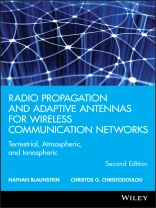Radio Propagation and Adaptive Antennas for Wireless
Communication Networks, 2nd Edition, presents a comprehensive
overview of wireless communication system design, including the
latest updates to considerations of over-the-terrain, atmospheric,
and ionospheric communication channels. New features include the
latest experimentally-verified stochastic approach, based on
several multi-parametric models; all-new chapters on wireless
network fundamentals, advanced technologies, and current and modern
multiple access networks; and helpful problem sets at the
conclusion of each chapter to enhance clarity. The volume’s
emphasis remains on a thorough examination of the role of
obstructions on the corresponding propagation phenomena that
influence the transmission of radio signals through line-of-sight
(LOS) and non-line-of-sight (NLOS) propagation conditions along the
radio path between the transmitter and the receiver
antennas–and how adaptive antennas, used at the link
terminals, can be used to minimize the deleterious effects of such
obstructions. With its focus on 3G, 4G, MIMO, and the latest
wireless technologies, Radio Propagation and Adaptive Antennas
for Wireless Communication Networks represents an invaluable
resource to topics critical to the design of contemporary wireless
communication systems.
* Explores novel wireless networks beyond 3G, and advanced 4G
technologies, such as MIMO, via propagation phenomena and the
fundamentals of adapted antenna usage.
* Explains how adaptive antennas can improve Go S and Qo S for any
wireless channel, with specific examples and applications in land,
aircraft and satellite communications.
* Introduces new stochastic approach based on several
multi-parametric models describing various terrestrial scenarios,
which have been experimentally verified in different environmental
conditions
* New chapters on fundamentals of wireless networks, cellular and
non-cellular, multiple access networks, new applications of
adaptive antennas for positioning, and localization of
subscribers
* Includes the addition of problem sets at the end of chapters
describing fundamental aspects of wireless communication and
antennas.
Jadual kandungan
Preface vii
Part I Fundamentals of Wireless Links and Networks
1 Wireless Communication Links with Fading 1
2 Antenna Fundamentals 34
3 Fundamentals of Wireless Networks 54
Part II Fundamentals of Radio Propagation
4 Electromagnetic Aspects of Wave Propagation over Terrain 81
5 Terrestrial Radio Communications 117
6 Indoor Radio Propagation 179
Part III Fundamentals of Adaptive Antennas
7 Adaptive Antennas for Wireless Networks 216
8 Prediction of Signal Distribution in Space, Time, and Frequency Domains in Radio Channels for Adaptive Antenna Applications 280
9 Prediction of Operational Characteristics of Adaptive Antennas 375
Part IV Practical Aspects of Terrestrial Networks Performance: Cellular and Noncellular
10 Multipath Fading Phenomena in Terrestrial Wireless Communication Links 413
11 Cellular and Noncellular Communication Networks Design Based on Radio Propagation Phenomena 494
Part V Atmospheric and Satellite Communication Links and Networks
12 Effects of the Troposphere on Radio Propagation 536
13 Ionospheric Radio Propagation 591
14 Land-Satellite Communication Links 639
Index 677
Mengenai Pengarang
NATHAN BLAUNSTEIN??is Professor of the Communication Systems Engineering Department at the Ben-Gurion University of the Negev, Beer Sheba, Israel. He is the author of numerous books and book chapters and articles on communication systems, and holds five patents in wireless communications and adaptive antennas, in geophysics and medicine.
CHRISTOS G. CHRISTODOULOU??is a Distinguished Professor of the Electrical and Computer Engineering Department at the University of New Mexico, Albuquerque and COSMIAC (Configurable Space Microsystems Innovations & Applications Center) Director. He is also the author of numerous book chapters and articles on communication systems, co-author of 5 books and holds three related patents.












